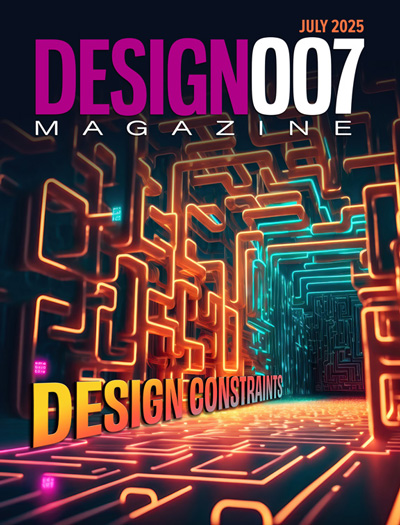-

-
News
News Highlights
- Books
Featured Books
- design007 Magazine
Latest Issues
Current Issue
Signal Integrity
If you don’t have signal integrity problems now, you will eventually. This month, our expert contributors share a variety of SI techniques that can help designers avoid ground bounce, crosstalk, parasitic issues, and much more.

Proper Floor Planning
Floor planning decisions can make or break performance, manufacturability, and timelines. This month’s contributors weigh in with their best practices for proper floor planning and specific strategies to get it right.

Showing Some Constraint
A strong design constraint strategy carefully balances a wide range of electrical and manufacturing trade-offs. This month, we explore the key requirements, common challenges, and best practices behind building an effective constraint strategy.
- Articles
- Columns
- Links
- Media kit
||| MENU - design007 Magazine
Creating a Design Constraint Strategy
July 24, 2025 | I-Connect007 Editorial TeamEstimated reading time: 2 minutes
Feature Q&A With Kris Moyer, Global Electronics Association
Most designers learn how to set their design constraints through trial and error. EDA vendors’ guidelines explain how to use their particular tools’ constraints, and IPC standards offer a roadmap, but PCB designers usually develop their own unique styles for setting constraints.
Is there a set of best practices for setting constraints? That’s what I asked Global Electronics Association design instructor Kris Moyer, who covers design constraints in his classes. In this interview, Kris discusses how to identify PCB design requirements and set design constraints tightly enough for performance but flexible enough for manufacturing limitations.
What pre-layout analysis should be performed before you begin setting constraints?
Kris Moyer: There are several analyses that should be completed before setting constraints. These include the following:
- Timing/signal integrity: Used to set controlled impedance, termination, length matching and max length, and layer restrictions for digital signals.
- SPICE/power integrity analysis: Used to define the power distribution network (PDN) limits, the current requirements (trace widths), and voltage clearance requirements (Cu-Cu clearance).
- Thermal analysis: Used to determine how many plane layers, the copper weight of the plane layers, temperature rise of the traces (also used to define trace width), and any heat-sinking needed.
- Structural/mechanical analysis: This is the vibration, shock, and other environmental impacts to the design. It’s used to trade off between how many copper layers vs. board thickness for the stackup, and it is also used to evaluate the number and locations of mount holes or other support structures for the board. This analysis also leads to placement restrictions, such as specific placement of tall parts due to the design of the enclosure, or heavy/high mass parts due to special support structures designed into the housing, etc.
- Material analysis: This is an investigation of any special materials that may be needed, such as RF materials, flex materials, etc. These all have an impact on the stackup of the PCB and often lead to routing restrictions. For instance, you can only route the RF signals on the RF layers, or you have fewer routing layers available in the flex sections vs. the rigid sections of a rigid-flex board, limiting your ability to route signals from one rigid section to the next.
To continue reading this Q&A, which originally appeared in the July 2025 Design007 Magazine, click here.
Testimonial
"Our marketing partnership with I-Connect007 is already delivering. Just a day after our press release went live, we received a direct inquiry about our updated products!"
Rachael Temple - AlltematedSuggested Items
Siemens, ASE Collaborate on Workflows for ASE’s VIPack Advanced Packaging Platform
09/25/2025 | SiemensSiemens Digital Industries Software announced that it is collaborating with Advanced Semiconductor Engineering, Inc. (ASE), the leading global provider of semiconductor manufacturing services in assembly and test, to develop 3Dblox-based workflows for the ASE VIPack™ platform using Siemens’ Innovator3D IC™ solution, which is fully certified for the 3Dblox standard..
Cadence, TSMC Team on AI-Driven Flows and IP for Advanced Nodes, 3DFabric
09/25/2025 | BUSINESS WIRECadence announced major advancements in chip design automation and IP, driven by its long-standing relationship with TSMC to develop advanced design infrastructure and accelerate time to market, for AI and HPC customer applications.
Siemens Collaborates with TSMC to Accelerate 3D IC and AI-driven Circuit and Systems Design
09/24/2025 | SiemensAt the 2025 TSMC North America Open Innovation Platform® (OIP) Ecosystem Forum, Siemens Digital Industries Software announced multiple new collaborations with TSMC, including product certifications and innovative design solutions enablement initiatives for the foundry’s newest and most advanced process technologies.
American Standard Circuits to Exhibit at the Battery Show 2025
09/24/2025 | American Standard CircuitsAmerican Standard Circuits/ASC Sunstone Circuits will be exhibiting at the Battery Show North America to be held at Huntington Place in Detroit, Michigan, October 6-9, 2025.
Blueshift Launches PhaseBlue 1500 Series Circuit Material
09/22/2025 | BlueshiftBlueshift, a U.S.-based technology leader in advanced materials, is introducing PhaseBlue® 1500, the first product in its Series Circuit Materials (SCM) line at this year’s (2025) European Microwave Show.


